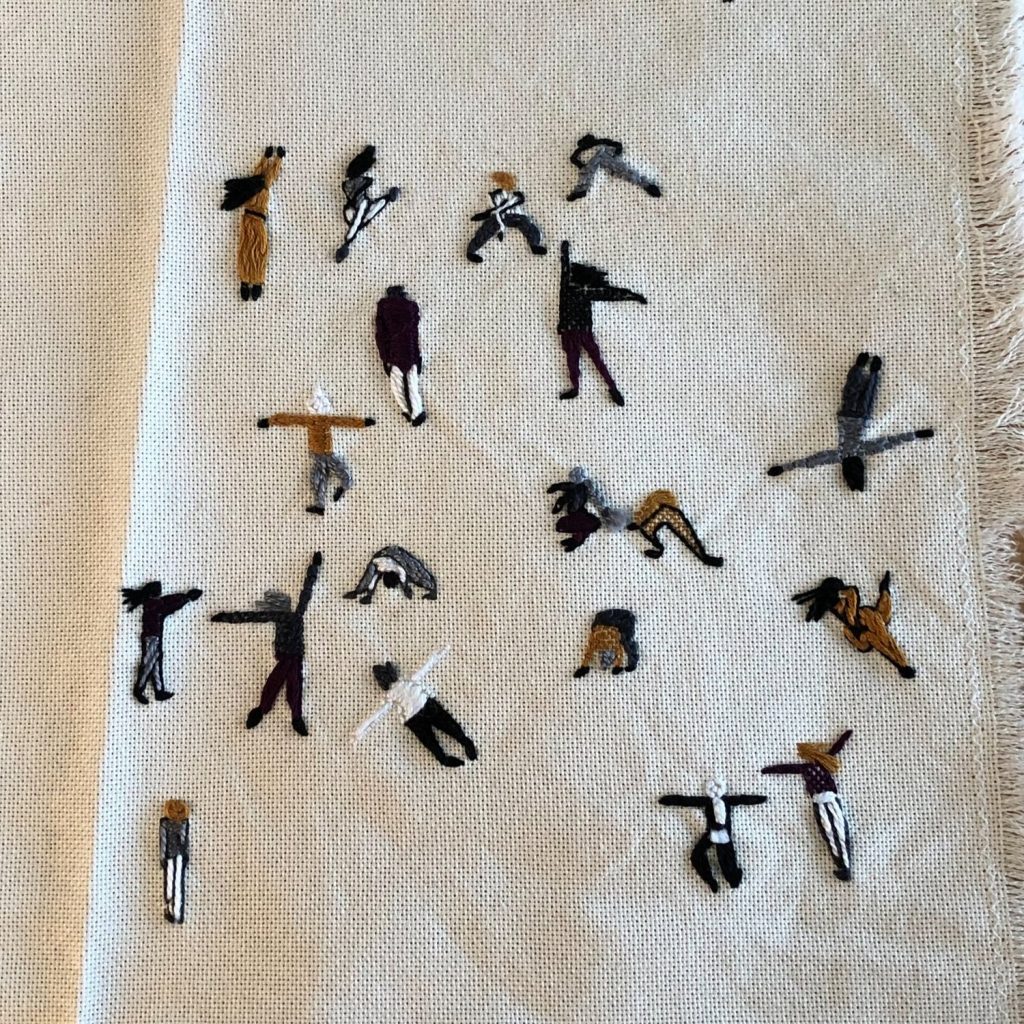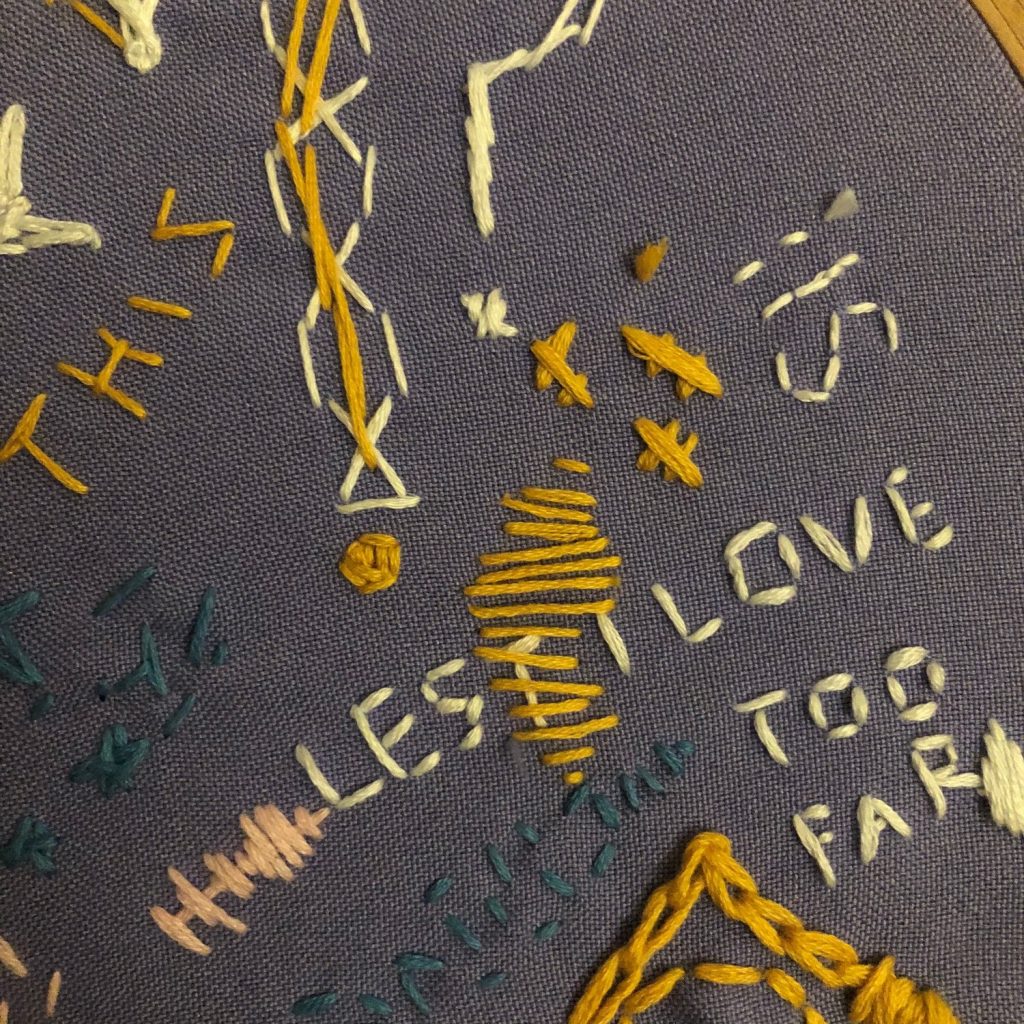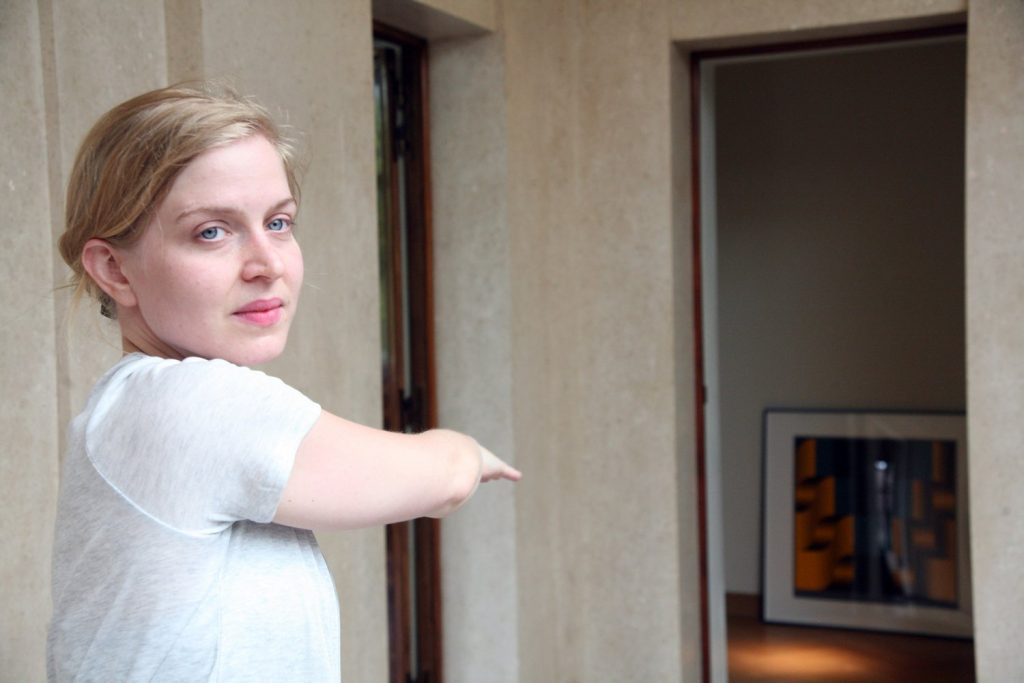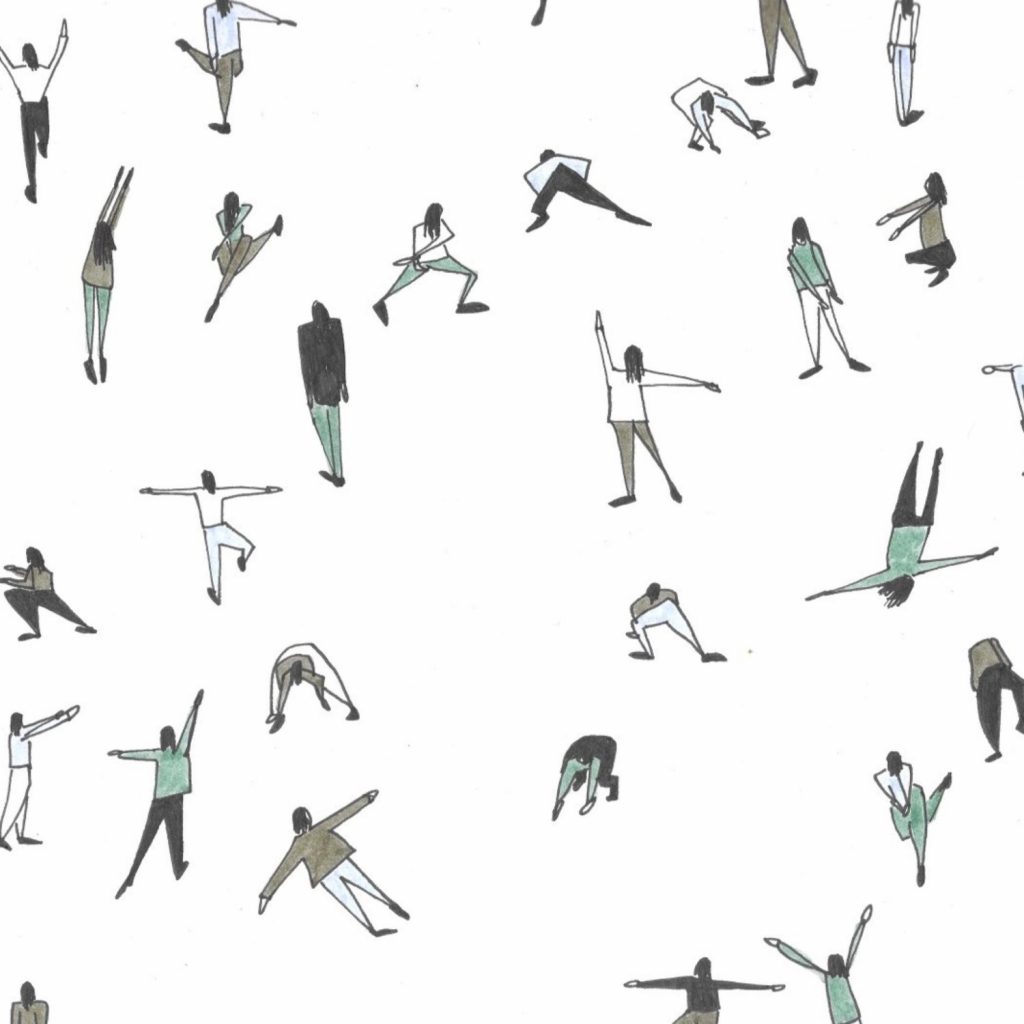by Else Tunemyr

In spring and summer 2020, the people involved in Satelliser: a dance for the gallery met online for sessions that at first were meant as a preparation for the forthcoming performance, and as the time of lockdown and cancelled performances dragged on, moved into an online conversation for the sake of talking and exchanging with each other. The sessions lasted for three hours, with shifting constellations of the group participants talking on selected but not strictly enforced subjects. As the meetings focused on speaking rather than dancing in groups mostly consisting of dancers, not surprisingly, physical activities emerged to accompany the talking. Many of us took up crafting as a way to keep active during times of lockdown. My craft of choice was embroidery and during this time my hoop, needles and yarn kept me company in front of every screen I found myself facing. Stitching and talking meant that for me, Satelliser and crafting (literally) went hand in hand .
Knitting, crocheting, quilting, sewing, embroidery, weaving, stiching: while doing something with my hands, in the present time, my mind could more easily engage in the conversations. Ann Cvetkovich writes how “crafting is a form of body politics where agency takes a different form than application of the will. It fosters ways of being in the world in which the body moves the mind rather than the other way around, or in which, echoing neurobiological views in another register, body and mind are deeply enmeshed or holistically connected”. Perhaps the stitches anchored me in the material world, the feeling of textile in my hands allowing me to be in the present although my discourse partners were hundreds of miles away. The tiny images of faces on the screen became palpable and graspable by the stitches on my canvas. The methodology of my embroidery stopped my mind from wandering off when listening to the group’s thinking and talking.
“As a practice, and not just an ephemeral feeling, crafting is not the homology or first step or raw material for some form of political change beyond it. It is already a form of self- transformation, although it can also be a way to build the spiritual warrior self necessary for doing other kinds of work in the world, including organized political activism” Ann Cvetkovich¹

When Satelliser moved from the online world into the gallery, the repeated dance phrase took the place of crafting, functioning to anchor but also to move the mind, and as such support the conversation. When following a score of how to move, the pattern of Satelliser becomes a type of embodied crafting which emphasises my physical being in the world and my relation to the other. Like crafting produces a certain state of mind for the crafter, so does the dance in Satelliser. From the onset of the performance, a vocabulary is established: that of continuous, slow paced, precise movement. From 10 am to 6pm the dancers are moving in the same unison sequence, never separating into individual material or expressions. At first the slow paced dancers may seem to be moving without direction, but if a visitor stays long enough they can notice a pattern emerging: that of the dancers orbiting (satellising) around a visitor with sustained eye contact. Just like a needle stitching each stitch to form an embroidered pattern, so the dancers’ limbs lead the way each step at a time making an invisible circular imprint in the room. The dancing sequence makes no narrative claim, and is not displaying the dancers’ virtuosity or giving surprises in dynamic shifts. Instead it carries the conversation forward and sideways or simply holds a rhythm for verbal silence. The dance stitches thoughts together, crafting a way throughout the day with bodies as the material of choice.


I propose to embrace the movement of Satelliser as a form of bodily crafting, and by doing so to consider it a generous practice in how bodies exist in relation to each other, tethering the transformation that the conversation is going through. This transformation takes place through the body via the mind and vice versa, together with the ongoing material of other bodies doing more or less the same thing. More in the sense that all dancers are clearly following the same pattern of movement, less in the sense that each dancer does the movement slightly differently from each other. Just as stitches in an embroidery can differ from each other and still create the pattern one wishes for, the difference in execution of the satellising dance forms a choreographic pattern, and one that, just like embroidery, does not disturb the thinking of what is being said. Through careful consideration of when and how thoughts are communicated and how the participants are cared for, I think of Satelliser: a dance for the gallery as a craft that creates conditions to surrender to fragile exposure without feeling threatened. The dancing is what anchors me and what allows for vulnerability to occur between and in front of strangers.
Satelliser: a dance for the gallery shares with crafting its ability to be both generative and restful, a bodily crafting which unfolds throughout the day. The specific modes of attention to both the self and the other, the repetitive movement of the body, the different ways of talking to one another, shares with crafting its ability to shift consciousness, which I find is the core of Satelliser’s transgressive potential.


This digital publication – satellising.com – holds together contexts around Satelliser: a dance for the gallery by J N Harrington & coworkers. It was produced by Zarina Rossheart, designed by John Philip Sage and J N Harrington, and supported using public funding from the National Lottery through Arts Council England, and John Ellerman Foundation through the CONTINUOUS Network. CONTINUOUS is a partnership project from Siobhan Davies Studios and BALTIC Centre for Contemporary Art.
About the Else Tunemyr (she/her)

Else Tunemyr (b. 1984 Sweden) lives in Malmö, Sweden. She works in different and changing collaborations and directions, dividing her time between dancing, performing, choreographing, doing dramaturgical work and teaching. Her practice has evolved around the topics of physical tiredness and presences of passivity, which also included reflections about the process of rehearsing and exhaustion in general. She studied for a BA in Dance Theatre at Laban, London, and a MA in Choreography and Performance at the Institute for Applied Theatre Studies, Giessen. Else aims for an interplay between speculative and embodied knowledge, most recently exploring the transgressive potential of touching practices. Questions that persist in her work are “is there a specificity to dance that can resist the logic of progress? And how would a choreographic process support this?
Else was an emerging Dance Artist in Residency at the Southbank Centre London, where she developed work shown at the Southbank Centre, Chisenhale Dance Space and Sadler’s Well’s Theatre. Parallell to her own choreographic work Else works as a dramaturg and performer and have been performing and collaborating with, Anta Helena Recke, Andrew Hardwidge, Benjamin van Bebber, Carolina Mendonça, Catalina Insignares, Les Trucs, Lygia Clark, Mårten Spångberg, Jamila Johnson-Small, J N Harrington, Mike Kelley, Simone Forti, Tino Sehgal, Xavier Le Roy and others.








